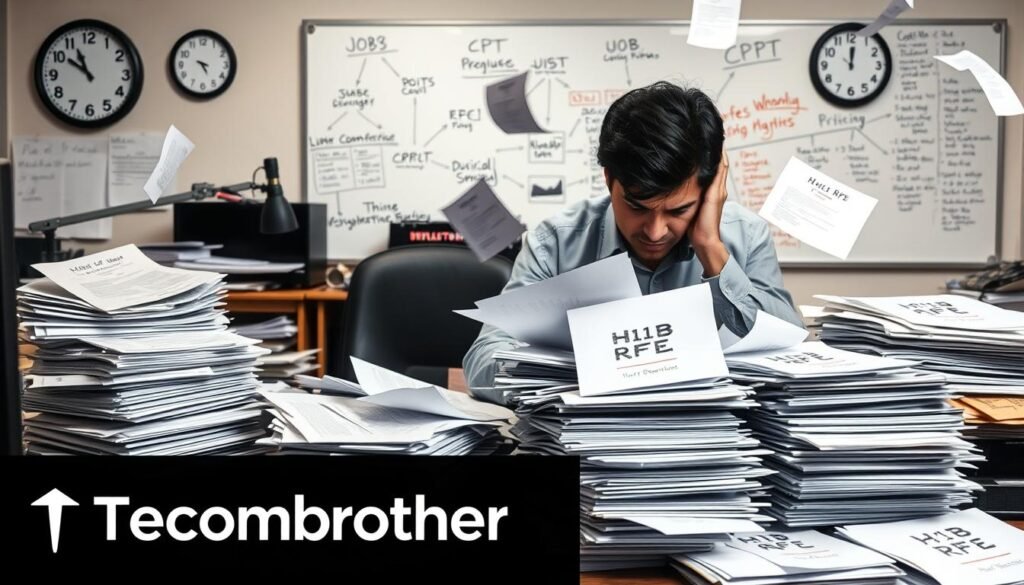Are you worried about your recent H1B Request for Evidence (RFE)? You might be wondering how to show the link between your Curricular Practical Training (CPT) program and your job. The journey to a successful H1B visa can seem tough. But, knowing the RFE process can make your application stand out.
In 2024, about 10% of applicants will get an H1B RFE. This might sound scary, but over 80% of people beat these requests. Your H1B RFE is a chance to add more evidence that makes your visa application stronger.
The U.S. Citizenship and Immigration Services (USCIS) asks for more info on your specialty job, education, and job fit. With RFE rates changing from 21.4% in FY 2017 to 9.8% in FY 2023, it’s key to write a strong response for your visa.
Key Takeaways
- An H1B RFE is an opportunity, not a rejection
- Prove the direct link between your CPT program and job role
- Prepare comprehensive documentation
- Maintain a GPA above 3.0 for work authorization
- Understand USCIS requirements thoroughly
Understanding the H1B RFE Process
Dealing with an H1B RFE (Request for Evidence) can seem like a big challenge. When USCIS asks for more info on your H1B application, they send an RFE. You need to answer it carefully and strategically.
What is an H1B RFE?
An H1B RFE is a document from USCIS asking for more details about your H1B application. Immigration officers might need more info to decide on your application.
“An RFE is not a denial, but an opportunity to provide missing evidence and strengthen your application.”
Common Reasons for H1B RFE
Knowing why USCIS might ask for more info can help you prepare better. Common reasons include:
- Specialty occupation criteria not clearly demonstrated
- Insufficient proof of employer-employee relationship
- Questions about work availability
- Beneficiary’s eligibility documentation incomplete
- Status maintenance concerns
How H1B RFE Affects Your Application
Getting an RFE can slow down your H1B application. The time it takes to respond to an RFE can be long, sometimes months. It usually takes about 10 days to get the RFE notice after your online status changes.
Many applicants face challenges at this stage. A lot of people struggle to prove they have a specialty occupation.
- Response deadline: Maximum of 12 weeks
- Voluntary withdrawal rate: Below 33%
- Potential to refile: 60 days after denial
It’s very important to answer an RFE carefully and accurately. Getting help from a professional can greatly increase your chances of success.
Importance of Your CPT Program in H1B RFE
Dealing with an H1B RFE can be tough, and your Curricular Practical Training (CPT) program is key. It’s vital to show how your CPT relates to your job for a successful H1B application.
Defining Your CPT Program
A CPT program lets international students get practical experience in their field. For H1B, your CPT must show a clear link between your studies and work. Schools like Westcliff University have programs that help students apply what they learn in class to real jobs.
How Your CPT Program Relates to Your Job
The USCIS looks closely at how your CPT connects to your job during an H1B RFE. They check things like:
- How your studies match your job
- How your coursework is directly relevant to your job
- Any practical training you’ve done

Supporting Evidence for the Link
To make your H1B RFE stronger, gather all the proof you can. Make a detailed portfolio with:
- Your academic transcripts
- A detailed job description
- Letters from your employer
“Documentation is key to showing your CPT program’s legitimacy and its link to your job.” – Immigration Expert
| CPT Element | Job Connection Evidence |
|---|---|
| Coursework | Syllabus matching job skills |
| Practical Training Hours | Detailed work logs |
| Academic Projects | Professional portfolio |
By tackling the H1B RFE requirements early, you show you’re serious about following the rules and growing professionally.
Preparing for H1B RFE Response
Handling an H1B RFE can be tough, but with the right prep, you can boost your chances. The rates of H1B RFEs have changed, but a solid response can really help.
Documenting Your Job Role
When you’re getting ready for your H1B documents, be precise. Your job role documents should clearly show your role’s unique aspects. Make a detailed list that includes:
- Specific job responsibilities
- Required qualifications
- Technical skills needed
- Educational background relevance
Collecting CPT Program Evidence
Your CPT program evidence is key for a strong H1B RFE response. Collect these important documents:
- Day 1 CPT RFE Support Letter
- Detailed Attendance Report
- CPT Corporate Agreement
- Enrollment Verification
- Official Transcript
- Academic Record
- Tuition Record
“The key to a successful H1B RFE response is meticulous documentation and clear evidence linking your academic background to your professional role.” – Immigration Law Expert
Writing a Strong Cover Letter for H1B RFE
Your H1B RFE response cover letter is your chance to address the issues directly. Write a compelling story that ties your CPT program, education, and job role together. Show how your skills match the job’s needs.
As H1B RFE response strategies change, knowing the detailed documentation needs is crucial. The approval rate after RFE has been between 68-79%, showing how important a thorough and well-prepared response is.
Key Documents to Include in Your H1B RFE Response
Handling an H1B RFE needs careful planning and the right documents. With RFE rates falling from 40.2% in FY 2019 to 9.6% in 2022, the right documents can boost your approval chances.
Your H1B documents are key to showing you’re eligible. The right papers can mean the difference between approval and denial.
I-20 and CPT Authorization
Your I-20 form is essential for H1B RFE evidence. It proves your academic background and Curricular Practical Training (CPT) authorization. Make sure to include:
- Complete I-20 document
- CPT authorization details
- Academic program information
- Training dates and duration
Employer Letters
Employer letters are crucial for H1B employer obligations. These letters should clearly show your professional relationship.
| Letter Component | Required Details |
|---|---|
| Job Title | Exact position description |
| Salary Information | Detailed compensation breakdown |
| Employment Duration | Start date, expected employment period |
Job Descriptions and Duties
Detailed job descriptions are key in an H1B RFE response. Your documents must clearly show how your academic training fits your current job.
“Precision in documenting job responsibilities can significantly improve H1B RFE approval rates.” – Immigration Law Expert
Include detailed materials that show how your CPT program ties to your job. The aim is to show a clear link from your academic training to your job.
Strategies to Strengthen Your H1B RFE Response
Handling an H1B RFE needs careful planning and detailed documents. Your response is key to your immigration chance. So, it’s important to tell a strong story.
Providing Clear Job Descriptions
When facing an H1B RFE, clear job descriptions are essential. Your job description must show your role fits the H1B specialty occupation. Use clear language to link your job duties to your specialized knowledge.
- Outline specific job duties
- Highlight technical skills required
- Demonstrate specialized knowledge
Demonstrating CPT Skills Relevant to Your Job
Your Curricular Practical Training (CPT) skills are vital for an H1B RFE response. Show how your school training fits your job skills. USCIS looks for a clear link between your education and work.
Expert opinions in RFE responses can help, leading to a 30% better chance of approval.
Using Case Studies and Examples
Real examples can really help your H1B RFE response. Share examples where your skills helped your employer. Include specific achievements to show your value.
Remember, a detailed and well-supported H1B RFE response boosts your approval chances. Be thorough and make sure all evidence supports your specialty occupation claim.
Common Mistakes to Avoid in H1B RFE Responses
Handling the H1B RFE process can be tough. Many people make big mistakes that can hurt their chances of getting a visa. Knowing these common errors can help you do better.

Ignoring Requested Evidence
One big mistake is not sending all the documents USCIS asks for. They need clear and complete evidence. If you don’t send everything, they might deny your application right away.
- Read the RFE carefully
- Gather all requested documents
- Double-check submission requirements
Missing Deadlines for H1B RFE
Time is very important when responding to an H1B RFE. You usually have 90 days to send in what they need. If you miss this deadline, they will reject your application.
“Timely response is your best defense in the H1B RFE process.” – Immigration Expert
Lack of Clarity in Job Duties
Being too vague about your job can cause more problems. USCIS wants to know exactly how your job fits into a specialty occupation.
| Weak Description | Strong Description |
|---|---|
| Computer Systems Analyst | Enterprise Network Security Specialist implementing advanced cybersecurity protocols |
| Generic job title | Specialized role with specific technical requirements |
By avoiding these mistakes, you can make your H1B RFE response better. Paying close attention to details, sending all the documents, and being clear in your answers are crucial for success.
Seeking Professional Help for H1B RFE
Handling an H1B RFE can be tough, but getting help can make a big difference. The right advice can turn a problem into a success story.
When to Consult an Immigration Attorney
It’s important to know when to ask for help with your H1B RFE. You should talk to an immigration lawyer if:
- You got a complex RFE with many documents needed
- You have special job or education situations
- You’re not sure how to put together a good H1B package
- You’ve had trouble with visa applications before
Benefits of Using Professional Services
Using a pro for your H1B RFE has many benefits:
- They know USCIS rules inside out
- They’ll check your documents carefully
- They’ll help you gather the right evidence
- They can make your application more likely to pass
Studies show that having an expert on your H-1B petition can lower denial rates a lot.
Preparing for a Successful H1B RFE
Before you get professional help, gather these documents for your H1B RFE:
| Document Type | Importance |
|---|---|
| Original RFE Notice | Key for knowing what you need to do |
| Educational Transcripts | Shows you’re qualified for your job |
| Employment Contracts | Proves you work for the company |
| Detailed Job Description | Confirms your job is a specialty occupation |
With about 60% of H-1B petitions with RFEs getting approved, getting professional help can give you an edge in getting your visa.
Conclusion: Enhancing Your H1B RFE Response
Dealing with the H1B RFE process can be tough. But, with the right strategies, you can tackle any USCIS requests. The secret to a great H1B RFE response is knowing your application well. You need to provide clear, detailed evidence that shows you’re qualified.
Your H1B RFE response should include clear documents, exact job descriptions, and strong supporting materials. Since about 30% of H1B applications get RFEs, being ready is key. Make sure you have all the needed documents, like job descriptions, CPT program evidence, and expert opinions that prove your skills.
Getting help from an immigration attorney who knows H1B applications can really help. They can help you write a strong response that meets USCIS’s needs. Having detailed, well-organized evidence is your best tool for answering an H1B RFE.
Start now by checking your documents, getting expert advice, and sending in a thorough response. Your hard work and preparation can turn the H1B RFE into a chance to show your professional worth and dedication to your career in the U.S.


